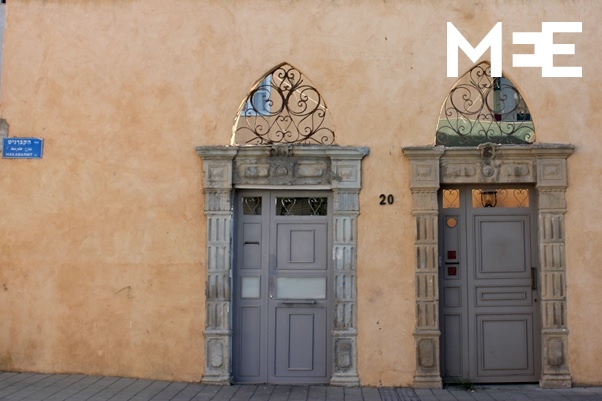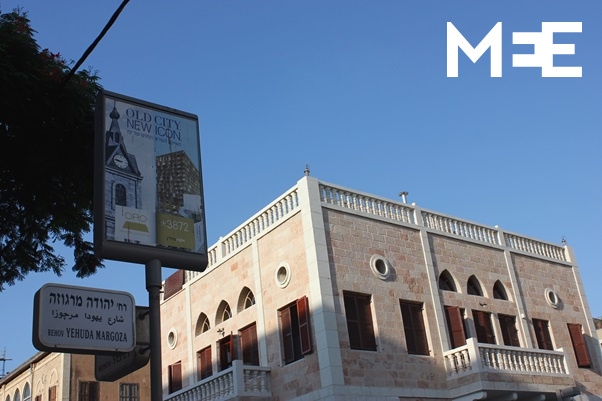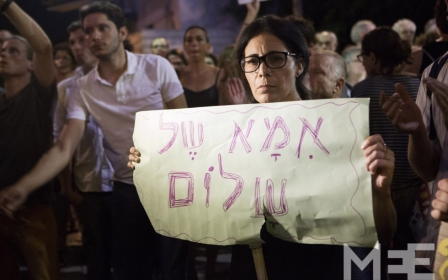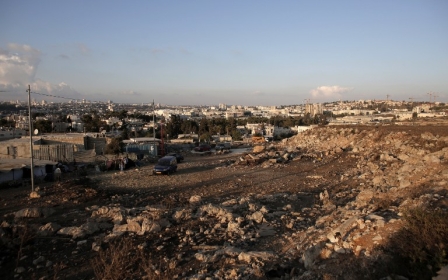Gentrifying Jaffa

JAFFA, Israel - Abu George is faced with the possibility of losing his third family home in Tel Aviv-Yafo (Jaffa), Israel - once part of historic Palestine. Now an old man, Abu George grew up in the Jaffa neighbourhood of Ajami. As a small boy he remembers sitting on the roof of his family’s Ottoman-era home and fishing in the Mediterranean - only a small road separated the palatial house from the shoreline. It was prime real estate then as it is now, although it is no longer possible to catch fish from atop the roof of the house.
Abu George's house was partially demolished in the late 1990s, along with many other houses in the Ajami neighbourhood, and only a skeleton of the building remains.
Changing its approach towards Jaffa, the Tel Aviv-Yafo municipality under Mayor Ron Huldai decided Jaffa could be an answer to the housing shortage in Tel Aviv and set out to gentrify the area with new developments, destroying old homes to make space. Until then, Jaffa was largely seen as an undesirable, poor Arab neighbourhood filled with crime, and urban planning policies restricted development.
Compounding the problem, the shoreline which was once very close to Abu George's house, has moved. A park now sits where waves once crashed. When houses were destroyed in Jaffa from the 1950s until the 1990s, rubble and waste was dumped in the sea at Ajami. As part of the gentrification, the municipality has turned the huge pile of rubbish into a park.
Abu George now lives in a three-room house. It was once twice as big: the old internal walls now act as external walls, with the archways of inner doorways visible outside.
As Abu George’s father rented the house before him, he has the right to stay there, but this rule does not apply to his son, the third generation. Abu George wants to purchase the house so that he can be sure his son’s family can live there, but the state won’t allow him to.
Yudit Ilany from the Popular Housing Committee of Jaffa said the Israeli state wants to develop the land Abu George's house is on as it is surrounded by new buildings and has direct access to the seafront.
“By law he should be able to buy; he has no rental debt, no illegal building. But it’s surrounded by new builds,” Ilany said. "The state doesn’t want to sell, because they know that if they don’t, they can take the land back when Abu George passes away... But Abu George is going to court to fight for the right to buy his home."
“That’s the punishment of living in Ajami,” said Abu George.
Gated communities
The first expensive housing project built in Jaffa was in the late 1990s, called Andromeda. Andromeda set the trend for high-end, exclusive housing.
“For the market it [Andromeda] was very important because the people saw you could build a project for rich people in Jaffa,” said Hicham Chabaita, lawyer at the Human Rights Clinic at Tel Aviv University.
Andromeda, a huge complex complete with private swimming pool, was built as a gated community and closed to the public, which is illegal as it is built on public lands.
"This is illegal," said Chabaita, who is also from Jaffa. He took the construction company to court and, after a three-year fight, he won the case with a ruling that all space has to be open to the public. Despite this, 10 years later, one can still only enter by being buzzed in.
Chabaita explained that while private construction companies are creating these housing projects, the state still has control over what is happening. This is because the government owns 93 percent of the land in Israel - it was made part of the Israeli constitution that land cannot be sold to anyone. They can only lease the land out for up to 99 years.
“So the decision whether the state sells its land is a political decision. The state can decide that it can sell it now, or at another time. It controls the timing. So it’s not really a free market,” said Chabaita.
"The result is that by choosing when to sell, the state chooses who to sell to," said Chabaita. “So I think when the state believes that if it sells the land in Jaffa it will be bought mainly by Jews, it will sell. But if it believes that most of the buyers will be Palestinians, it won’t sell.”
In the case of Andromeda, they knew this would result in rich Jews living there, as this is who the neighbourhood was marketed towards. “Before gentrification we had state control. Now the state doesn’t need to control it directly, it needs only to let the market do its work,” said Chabaita.
In some cases the construction companies don’t just market their houses towards the rich but also subtly discriminate who they rent to. The construction project Yopea has openly stated that they are for Jews only. Chabaita said: “There isn’t a law in Israel that prohibits discrimination in housing between private individuals.”
Sami Abu Shahadeh, member of the Popular Housing Committee for Jaffa, is eager to remind MEE that while gentrification began in the 90s, Palestinians have been consistently driven from Jaffa since 1948. Forcibly displaced, the population went from 120,000 to 4,000. Then Jaffa was relegated to the status of being an area inside the municipality of Tel Aviv and no longer a town in its own right.
“Jaffa is only in the imagination and memory of the people,” said Abu Shahadeh.
Even among the 4,000 who stayed in Jaffa, very few were able to remain in their original homes. The absentee property law, created in 1948 so that the houses of people who were expelled belonged to the state, meant they had little control over their houses.
In the 1960s a northern neighbourhood, Manshieh, where thousands of people lived, was turned into a promenade. During the 1970s and 1980s hundreds of houses in Ajami were destroyed. There was also a freeze on building and renovation, which meant owners could not renovate or do substantial repairs.
Fined for making repairs
“Ajami was declared a frozen area. So people were not allowed to do anything in their houses. They could not renovate, even if the roof was falling on their head,” said Abu Shahadeh. There are around 500 families who broke these rules at that time and are being fined today.
“In the 1970s they should have paid a fee of 10,000 shekels, but now it’s [grown to] half a million [around $128,000],” said Abu Shahadeh.
Another contributing factor to today’s gentrification is the artist village that was created in the Old City during the 1960s. Ilany said the growth of this, and the designers and boutiques that came with it, began to change the perception of Jaffa, and still continues to do so today.
“Gentrification has another component; there’s nowhere to go,” said Abu Shahadeh. “There’s nowhere for Palestinians to go because they are surrounded by Jewish areas with no Arab schools, or mosques or churches.”
This means many families live in increasingly cramped conditions sometimes with three generations in one house, and many people sharing a bedroom.
Nowhere to go
Ahmad Balaha from the municipality agreed that there was nowhere else for Arab residents to go, but said that the municipality "doesn’t have land they can build on for public housing. The municipality built 26 [houses under an affordable housing scheme] in Jaffa. It’s not enough, but the municipality doesn’t have more land.” These 26 houses were built in the early 1990s, and since then more expensive housing projects have been built.
Balaha acknowledged that these expensive housing projects are divisive for society, which is a problem for Palestinian citizens of Israel who are from Jaffa. But nonetheless he added, “Jaffa was neglected for 50 years but the municipality closed the gap. A lot of money went to Jaffa - to the infrastructure, tourism, gardens, kids, parks.”
Growing up fishing from his roof, Abu George went on to become a fisherman, sailing from the Jaffa port, but this too is becoming a rarity. “They killed the Jaffa harbour. We would see fisherman and ships, now it has become like a big bar,” said Abu George. The area is lined with bars and frequented by tourists.
While he continues his fight to buy his house, he can only watch as more of historical Jaffa changes around him.
New MEE newsletter: Jerusalem Dispatch
Sign up to get the latest insights and analysis on Israel-Palestine, alongside Turkey Unpacked and other MEE newsletters
Middle East Eye delivers independent and unrivalled coverage and analysis of the Middle East, North Africa and beyond. To learn more about republishing this content and the associated fees, please fill out this form. More about MEE can be found here.






